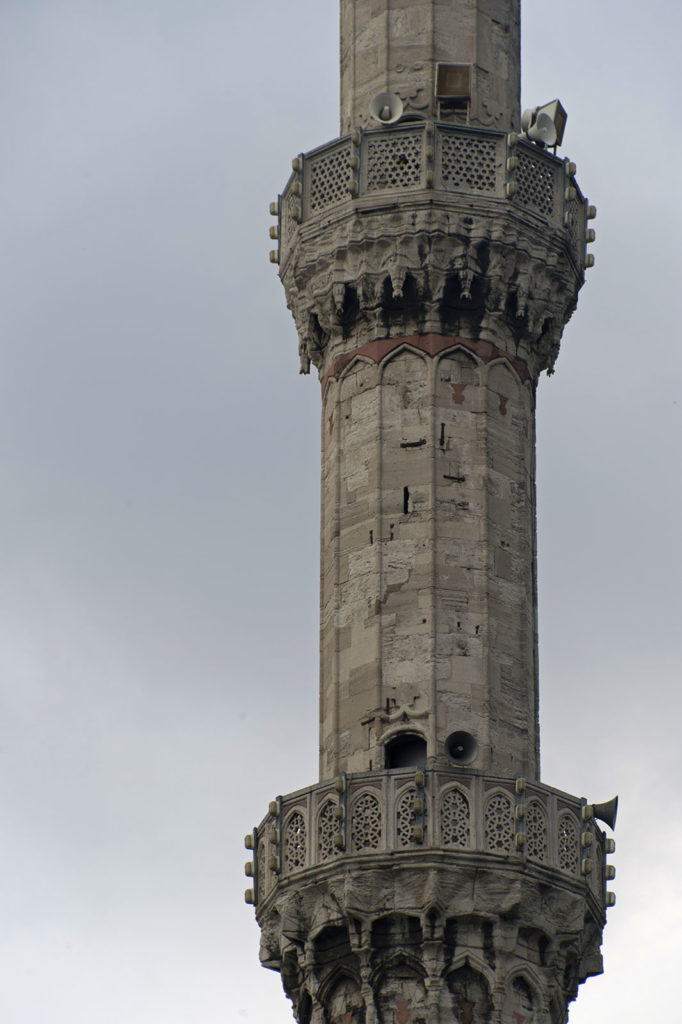Identity of the Empire: Ottoman mosque complexes and the muqarnas vault
A major characteristic of Ottoman mosques from the early period is the dominance of a central dome that covers a significant part of the prayer hall. With the advent of the classical Ottoman phase, this central dome increases dramatically in size and is often combined with a series of half-domes and small domes that cascade from the central dome, with the overall arrangement fitting within a pyramidal outline. A number of mosques have one, two, or four half-domes supporting the central dome. The domes in Ottoman architecture have a semi-circular flat profile. An arcaded courtyard usually flanks the prayer hall along the façade located opposite the qibla wall–the wall which indicates the direction of the holy city of Mecca.
Large imperial Ottoman religious complexes usually feature a significant number of facilities, which, in addition to a mosque may include a mausoleum for the patron, a soup-kitchen, religious schools, public bath, hospital and shops.
The Ottoman mosque is distinguished by elegant pencil-shaped minarets, which are often fluted and end in a lead-covered, elongated conical cap. Such minarets are a clear indication of Ottoman-sponsored buildings throughout the Ottoman Empire. The minarets may have anything from one to three galleries, or balconies, usually resting on corbelled muqarnas vaults. Mosques with royal patronage have multiple minarets, from two to six.
The muqarnas is used selectively in certain areas, such as the underside of minaret balconies or above windows and portals. It is used as a load-bearing and transitional element, allowing the weight of the domes to be dispersed to the walls upon which they rest, as is seen at the Süleymaniye Mosque. The muqarnas vault is also used as a decorative element, as is seen on the minarets of the Shezade Mehmed mosque.
Source:
Adapted from ‘Museum with No Frontiers, Administrated on behalf of the Consortium by Museum Ohne Grenzen, e.V., accessed August 18, 2019.
Architectural Images
- Topkapı Palace, Sea Gate, Istanbul, Turkey
- Sehzade Mosque, interior. Istanbul, Turkey
- Topkapı Palace, Imperial Harem, reception room, Istanbul Turkey
- Topkapı Palace, Imperial Gate/Cannon Gate, view from exterior. Istanbul Turkey
- Topkapı Palace, Imperial Harem, reception room. Istanbul Turkey
- Sehzade Mosque, Interior. Istanbul, Turkey
- Great Mosque of Kairouan, Egypt, with Ottoman additions
- Topkapı Palace, Imperial Gate/Cannon Gate, looking toward Hagia Sophia. Istanbul, Turkey
- Topkapı Palace, Baghdad Kiosk, Interior dome, Istanbul, Turkey
- Mosque of Sultan Ahmet, west exterior view, Istanbul, Turkey
- Topkapı Palace, Tulip room, Istanbul, Turkey
- Baghdad Kiosk, exterior. Topkapı Palace, Istanbul, Turkey
- Detail: Minaret. Sehzade Mosque, Istanbul, Turkey
- Topkapı Palace, View from Bosphoros, Istanbul, Turkey
- Topkapı Palace, Kitchen roof, Istanbul, Turkey
- Sehzade Mosque, Istanbul, Turkey
- Türbe (tomb), Mosque of Sultan Ahmet, Istanbul, Turkey
- Aerial view, Topkapı Palace (upper), Hagia Sophia (middle) Mosque Complex of Sultan Ahmet (lower), Istanbul, Turkey
- Sehzade Mosque, interior, Istanbul, Turkey
- Detail: Minaret. Sehzade Mosque, Istanbul, Turkey

